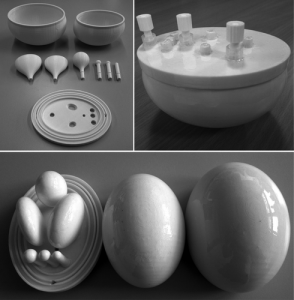
“Printing technology, capable of producing three‐dimensional (3D) objects, has evolved in recent years and provides potential for developing reproducible and sophisticated physical phantoms,” the researchers state. “3D printing technology can help rapidly develop relatively low cost phantoms with appropriate complexities, which are useful in imaging or dosimetry measurements. The need for more realistic phantoms is emerging since imaging systems are now capable of acquiring multimodal and multiparametric data.”
Three questions are posed by the researchers:
- Is the resolution of 3D printers sufficient for existing imaging technologies?
- Can materials of 3D printed phantoms produce realistic images representing various tissues and organs as taken by different imaging modalities such as computer tomography (CT), positron emission tomography (PET), single‐photon emission computed tomography (SPECT), magnetic resonance imaging (MRI), ultrasound (US), and mammography?
- How feasible or easy is it to print radioactive or nonradioactive solutions during the printing process?
“However, better coverage of materials would have been helpful to develop realistic phantoms, achieving sizes of tissues and organs comparable to those of humans and animals,” they add. “The materials of the printers are yet to demonstrate the extent of what is required for tissues or organs so that they can be used in multimodality hybrid imaging. In addition, there have been only limited discussions or investigations on how the radioactive solutions may affect the properties of the 3D‐printed materials.”
There is a lot of potential for growth in this area, the researchers continue, but companies that develop the 3D printers and materials should consider a wider range of material properties useful in medical imaging. They also propose the development of a 3D printer specifically designed for 3D printing phantoms.
“3D‐printed phantoms will be pivotal in the evolution of the medical imaging field, as they give the opportunity to test and improve several aspects of the scanners’ hardware and software,” the researchers conclude. “At the moment, it is feasible to use some specific phantoms for two or three imaging modalities, however, the technology requires further improvement for use with multimodality systems.”
The paper is an extremely detailed look at the many 3D printers and materials used to 3D print phantoms, and it also suggests looking more toward the bioprinting of phantoms for better biological realism. Soft, moving 3D printed phantoms are discussed, as well as phantoms containing fluids and radiotracers. 50 studies are discussed in total, and overall the researchers conclude that 3D printing is an effective method of producing phantoms – and that it has a lot more potential to do so in the future.
Authors of the paper are Valeria Filippou and Charalampos Tsoumpas.
Discuss this and other 3D printing topics at 3DPrintBoard.com or share your thoughts below.
